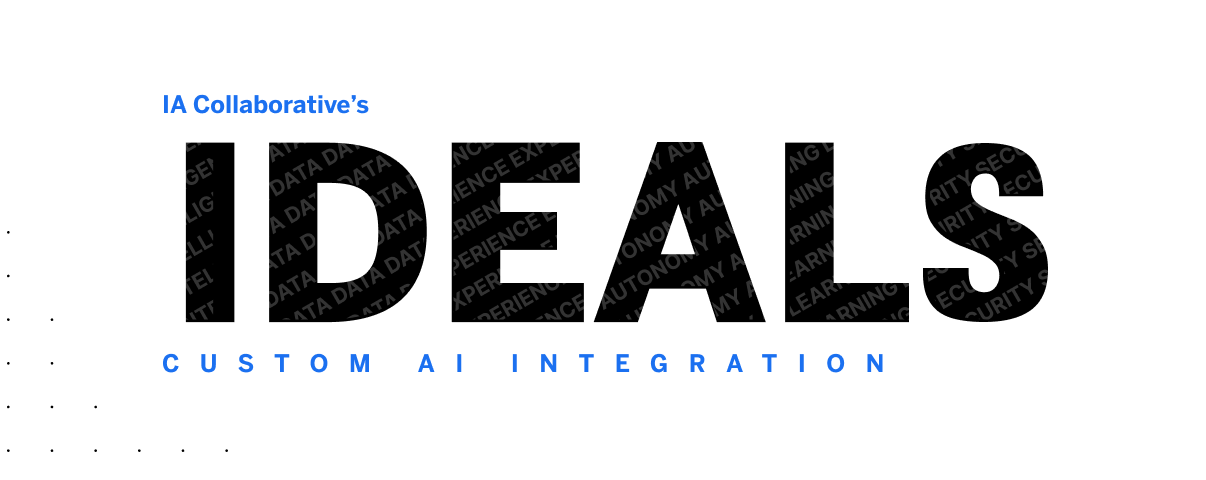Insights
The IDEALS Model: Six Elements That Can Make or Break Your Custom AI Implementation
Custom AI tools, for all their complexity and specificity, follow certain patterns. Every implementation is different, but in order to function effectively, every AI tool needs several key components, which determine how it accesses resources, what underlying models it uses, and how people engage with it. Understand these components and you’re well on your way to an AI implementation that’s appropriate to your needs and ready to deliver real ROI for your organization.
…the process we use for designing and implementing effective custom AI tools, starts by rigorously considering the questions outlined by IDEALS.
Having analyzed many such tools—and built several of our own—we’ve recognized that these components can be categorized into five elements: Intelligence, Data, Experience, Autonomy, Learning, and Security, or what we’ve identified as the “IDEALS framework”. Nearly any AI tool you’ve experienced over the last couple of years can be clearly defined by these five dimensions.
Human-Centered Workflow Analysis—the process we use for designing and implementing effective custom AI tools—starts by rigorously considering the questions outlined by IDEALS. Deciding how to proceed with each of the five variants depends entirely on your organization and your unique business challenges.


Intelligence
What model, algorithm & context will we engineer?
A customized AI tool often requires more than one model to operate effectively. This makes it critical to develop a mix that works best for your unique needs.
Large Language Models (LLMs) are ubiquitous, but they’re far from the only models out there, and are rarely ideal for every task a tool must perform. True to their names, LLMs excel at language, while related Large Reasoning Models (LRMs) excel at reasoning. But both often require strong support from data science and algorithmic AI to ensure their outputs are aligned with business logic, regulatory requirements and the specific task at hand.
An effective AI solution might use an analytic model to ingest unstructured data, a generative model to reason through complex logic (e.g., ChatGPT o3), and a different generative model to generate polished responses tailored to its intended users, using a chat-like interface (e.g., Claude Sonnet). The right combination yields a layered, orchestrated system where every component has a job, and works together toward a smarter, faster, more valuable whole.
Get the architecture right, and AI stops being experimental, and starts acting as a scalable engine for transformation. This is why it’s crucial to build familiarity and expertise in a wide range of AI models and tools, and ensure that you’re choosing the combination of intelligence best suited to your needs…and not just the one you’re most comfortable with.

Data
What data sources and integrations will unlock value?
In the AI era, data is a core strategic asset for enterprise leaders. It’s what fuels LLMs and LRMs, shaping how they perform, what they understand, and how they differentiate. Proprietary data creates a competitive edge, third-party data adds context, and novel sources inject freshness. AI excels at discovering meaning in large bodies of information, so the better your data, the smarter your AI.
But to generate real value, a custom AI tool requires effective data governance, in which a variety of structured and unstructured data—documents, interviews, strategies, proprietary knowledge graphs, mixed media, etc.—are ingested into a searchable vector database. This creates a fast, flexible foundation of shared intelligence that powers AI tools across your workbench. Choosing the right data sources and integrations, then, is critical to unlocking insight that generates real value.
One of the greatest advantages of a custom AI tool is the ability to train it on internal, proprietary data, or specialized data that’s specific to your industry and problem space—a process known as Retrieval-Augmented Generation, or RAG. Think of this as creating a secure library your AI tools can visit—retrieving only what’s needed, when it’s needed. The result: faster, smarter, and more accurate outputs, grounded in your own enterprise intelligence.

Experience
How will it be used?
For any kind of digital tool, user experience is no longer a layer on top of the back-end system—it is the system. For AI in particular, users now expect to engage in dynamic, one-on-one conversations with dynamic systems that respond, adapt, and generate in real time. Custom AI tools are often used for decision support, so it’s critical to define what decisions your people need to make, what a successful decision looks like, and what kind of interface is going to get them to it as quickly and intuitively as possible.
To be truly human-centered, these tools require emotionally intelligent interactions that make people feel confident rather than confused. Instead of static interfaces, the best AI tools will be responsive systems that are:
- Multi-Modal – Seamlessly returning text, voice, image, and video
- Context-Aware – Adapting to user preferences, behaviors, and environments
- Generative – Dynamically creating one-on-one interfaces for each moment
- Intuitive – Anticipating needs and guiding users with minimal effort
Such systems are becoming ubiquitous. We believe a new intelligence layer—agentic, adaptive, and embedded—will soon sit atop most traditional apps and sites, redefining how people engage with digital systems.

Autonomy
How independently capable is it?
When designing a modern AI tool, there’s often a tendency to aim immediately for full autonomy. In practice, though, this may not make sense for many enterprise-grade solutions, at least initially.
When developing a new agent, it’s critical to make a realistic assessment of when a human in the loop is needed—to guide decision-making, apply judgment, and sign off before action—and when autonomous action makes more sense. Especially in workbench environments where AI tools are passing data and tasks between one another, human oversight may be critical to ensure accuracy, reliability, and strategic alignment.
As enterprise AI shifts from standalone tools to orchestrated ecosystems, each organization’s leadership has the responsibility to design an appropriate flow of autonomy and oversight. Often this takes the form of a dynamic system map, defining how tools interact, when they act independently, and when they escalate for human input. The level of independence each tool is given depends on the complexity of the task, the clarity of the objective, and the sensitivity of the output, among other variables.
This kind of mapping should be iterative, where the map is a dynamic document, updated and refined as your AI ecosystem evolves and is able to perform more tasks autonomously. Modern AI tools require iteration and evaluation from the start—otherwise you risk the tool being either too generic, or quickly reaching a plateau.
Generative AI looks impressive at first glance, but without rigorous, domain-specific learning loops, it rarely delivers the accuracy, depth, or nuance required for real business impact. In our experience, the highest-performing tools come out of early investment in evaluation, so that inputs and outputs can be audited, and resulting insights used to shape system behavior.

Learning
How will it learn and improve?
One of the greatest long-term advantages of machine learning and related technologies is their ability to self-improve over time. Techniques like fine-tuning, reinforcement learning, and adaptive retraining allow models to evolve in response to real-world inputs, refining outputs, improving accuracy, and aligning more closely with business context over time. The result is an AI system that compounds in value with every interaction.
This learning process is initially a very human one, with people evaluating outcomes and suggesting adjustments. As the system evolves, more of the learning can become automated, but it should always be built upon a human-defined template, and reviewed regularly to check for drift. Moreover, the process must be built into the tool from the beginning, or else your organization runs the risk of never implementing one, effectively surrendering the tool to obsolescence.

Security
How will it ensure privacy, compliance and trust?
Although security is part of both Data and Autonomy considerations, this is a significant enough concern that it deserves a certain amount of undivided attention. In order for AI agents to be effective, they often need access to proprietary or sensitive information, and approval to execute tasks—like transferring money or sending out communication—that could have serious negative consequences if done wrong.
Any AI agent, therefore, must be subject to a step-by-step examination of potential risks at every stage in its workflow, along with worst-case scenarios and clear mitigation strategies. Designating a “red team” to intentionally misuse an agent in order to spot potential risk areas is often good practice here—it’s far better to discover a vulnerability during planning and refinement than after launch.
Risk reduction and mitigation often comes down to building a more secure tech stack. This includes taking care to limit who can direct an agent and receive results from it, and noting any point at which it accesses data or compute remotely, opening it to potential hacking. Like the other considerations, Security is one that should be built in from the earliest stages of planning: it’s far easier to design an agent with it in mind than try to bolt it on later.
Answer the Questions, Then Build the Tool
Building a robust, effective custom AI tool starts with a complex decision-making process. The technology is incredibly powerful and improving rapidly, but without knowing what you’re trying to achieve, what kinds of intelligence and data you’re relying on, and what constraints you need to set, all that power could easily take you rapidly in the wrong direction. Thinking through the IDEAL flow, and making honest assessments based on them, is the best way we’ve found to ensure your AI tool brings you real ROI, and not just more confusion.